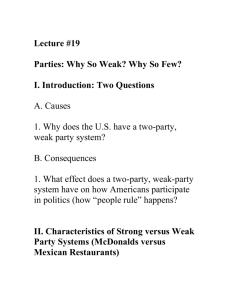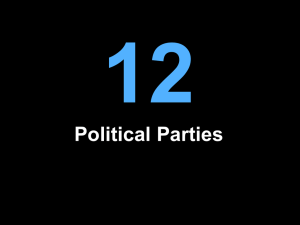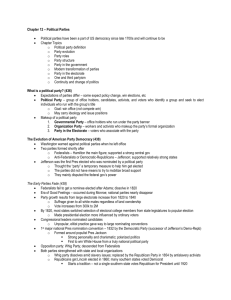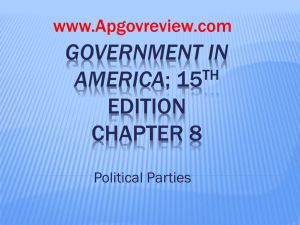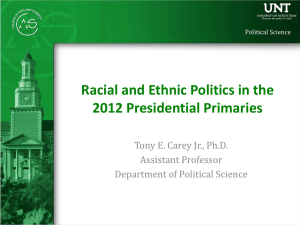AP Government: Political Parties Chapter 8 Outline
advertisement
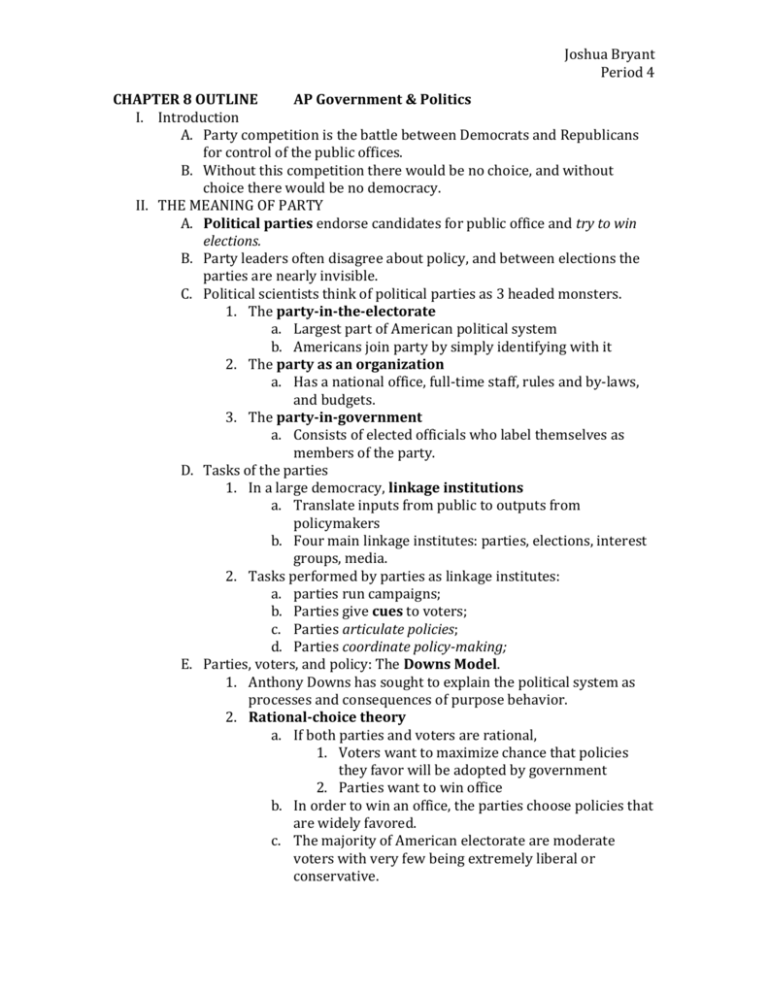
Joshua Bryant Period 4 CHAPTER 8 OUTLINE AP Government & Politics I. Introduction A. Party competition is the battle between Democrats and Republicans for control of the public offices. B. Without this competition there would be no choice, and without choice there would be no democracy. II. THE MEANING OF PARTY A. Political parties endorse candidates for public office and try to win elections. B. Party leaders often disagree about policy, and between elections the parties are nearly invisible. C. Political scientists think of political parties as 3 headed monsters. 1. The party-in-the-electorate a. Largest part of American political system b. Americans join party by simply identifying with it 2. The party as an organization a. Has a national office, full-time staff, rules and by-laws, and budgets. 3. The party-in-government a. Consists of elected officials who label themselves as members of the party. D. Tasks of the parties 1. In a large democracy, linkage institutions a. Translate inputs from public to outputs from policymakers b. Four main linkage institutes: parties, elections, interest groups, media. 2. Tasks performed by parties as linkage institutes: a. parties run campaigns; b. Parties give cues to voters; c. Parties articulate policies; d. Parties coordinate policy-making; E. Parties, voters, and policy: The Downs Model. 1. Anthony Downs has sought to explain the political system as processes and consequences of purpose behavior. 2. Rational-choice theory a. If both parties and voters are rational, 1. Voters want to maximize chance that policies they favor will be adopted by government 2. Parties want to win office b. In order to win an office, the parties choose policies that are widely favored. c. The majority of American electorate are moderate voters with very few being extremely liberal or conservative. Joshua Bryant Period 4 d. Although we frequently hear criticism that there is not much difference between the Democrats and Republicans, many say that they can see many more major differences now than in the past. e. From a rational-choice perspective, one should expect parties to differentiate themselves at least somewhat. III. THE PARTY IN THE ELECTORATE A. The party in the electorate 1. There is no formal membership in the parties. 2. For most people, the party is a psychological label. B. Party images help shape people’s party identification--1. The clearest trend in party identification is the decline of both parties and the upsurge of independence. 2. Virtually every major social group (except African-American voters) have moved towards a position of increased independence. 3. By contrast, African-Americans have moved even more towards the Democratic party. C. Party identification remains strongly linked to the voter’s choice, 1. Not only are there more Independents now, more people who still align with a party don’t remain as loyal in the booths. 2. Divided government has frequently been the result of voters failing to make an across-the-board choice between parties. IV. THE PARTY ORGANIZATIONS: FROM THE GRASS ROOTS TO WASHINGTON A. American political parties are decentralized and fragmented. 1. Unlike many European parties, American parties have no organization and no power in the government. 2. Candidates in the United have little power compared to European party leaders and candidates. B. Local parties: the dying urban machines 1. Urban party organizations used t be the main political party organization in American. 2. At one time urban parties were dominant. a. From the late nineteenth century through the New Deal of the 1930s, scores of cities were dominated by party machines. C. The fifty state party systems. 1. American national parties are a loose aggregation of state parties, which are themselves a fluid association of individuals, groups, and local organizations. 2. There are fifty state party systems, and no two are exactly alike. 3. States determine how easy it is to participate in nomination contests by their adoption of one of three types of elections: closed primaries, open primaries, and blanket primaries. Joshua Bryant Period 4 D. The national party organizations. 1. The national convention is the supreme power within each of the parties. a. Meets every four years, and writes party’s platform and nominate its candidates for president and vice president. 2. The national committee keeps the party operating between conventions. a. Includes representatives from states and territories 3. Day-to-day activities of the national party are the responsibility of the national chairperson. V. THE PARTY IN GOVERNMENT: PROMISES AND POLICY A. Party control does matter because the elected officials who represent it generally try to turn campaign promises into action. B. Since candidates are now much less dependent upon parties to get nominated and elected, that “control” is much less fixed than it used to be. C. Voters and coalitions of voters are attracted to different parties largely based on the party’s performance in government and its policies. D. The parties have done a fairly good job over the years of fulfilling their promises to the voters. VI. PARTY ERAS IN AMERICAN HISTORY A. In contrast to the United States, most democratic nations have more than two major parties. B. Throughout American history, America has always been a two party system. 1. Party eras were punctuated by critical elections, political earthquakes. Fissures appear in parties, new issues arise, and a party’s coalition starts to fracture. 2. A party realignment (a rare event) is typically associated with a major crisis or trauma in the nation’s history (such as the civil war). 3. A new coalition (a set of individuals or groups supporting the party) forms at the introduction of a critical event that tests the party’s loyalty. 4. A critical election period may require more than one election before change is apparent. C. 1796-1824: The first party system 1. Alexander Hamilton helped inaugurate our party system. 2. Hamilton needed congressional support for his pet policies, particularly a national bank. 3. The Federalists were America’s shortest-lived major party, fading quickly after John Adams was defeated in his reelection bid in 1800. D. The Democratic-Republicans (also known as Jeffersonians) Joshua Bryant Period 4 E. F. G. H. 1. General Andrew Jackson founded the modern American political party. 2. Jackson was originally a Democratic-Republican, but soon after his ascension to the presidency his party became known as simply the Democratic Party, which continues to this day. 3. Jackson’s successor, Martin Van Buren, was the behind-thescenes architect of the Democrats. 4. The Whigs had two distinct wings – Northern industrialists and Southern planters – who were brought together more by the Democratic policies they opposed than by the issues on which they agreed. 1860-1928: The Republican Era. 1. The issue of slavery dominated American politics and split both the Whigs and the Democrats. 2. The Republican Party rose in the late 1850s as the antislavery party. 3. The Republicans forged a coalition strong enough to elect Abraham Lincoln as President and ignite the civil war. 4. The Civil War brought a party realignment, which allowed the Republican Party to thrive for nearly 60 years after the war. 5. The election of 1896 was a watershed during this era- starting the second Republican Era and igniting one of the coldest political battles in American history. 6. The republicans continued as the nation’s majority party until the stock market crashed in 1929. 1932-1964: The New Deal coalition 1. President Herbert Hoover’s handling of the Great Depression was disastrous for the Republican party. 2. Franklin D. Roosevelt promised a New Deal of reforming the economy with legislative measures. 3. Congress passed scores of anti-depression legislature. 4. Party realignment began in earnest after the Roosevelt administration got the country moving again. 1968-present: The era of divided government 1. Although the Democrats have been the majority party, recent patterns have shown that a split government is becoming more common. 2. An unprecedented period of divided government has marked a period of discrepancy between he pattern of elected president and control of congress. 3. It is likely that divided party government is now becoming commonplace among state governments. Party dealignment means that people are slowly moving away from both political parties. Joshua Bryant Period 4 1. Many political scientists believe that the recent pattern has shown how the party system has dealigned rather than realigned. 2. Many scholars fear that the parties are becoming useless, just as a car is useless without a steering wheel. 3. Conversely, there are also some signs of party renewal, 4. The recent dealignment has been characterized by a growing party neutrality. 5. Those who do identify with a party are 6. Even though party loyalty has lagged, party organizations have become more energetic and effectiveVII. THIRD PARTIES: THEIR IMPACT ON AMERICAN POLITICS A. There are three basic varieties of third parties. 1. Parties that promote certain causes – either a controversial single issue or an extreme ideological position such as socialism or libertarianism. 2. Splinter parties that are offshoots of a major party – such as Teddy Roosevelt’s or Strom Thurmond’s States’ Righters. 3. Parties that are an extension of a popular individual with presidential aspirations – such as John Anderson and Ross Perot. B. Importance of third parties. 1. Third parties have controlled little major offices but have had a major influence. 2. They have brought new groups into the electorate and have served as “safety valves” for popular discontent. 3. They have brought new issues onto the political agenda. C. Consequences of the two-party system 1. The most obvious consequence of two-party governance is the moderation of political conflict. a. With just two parties, extreme and unconventional views are throttled. b. The result is often political ambiguity – why should they take a stand on controversial issues if doing so will only antagonize many voters? 2. One of the major reasons the United States has only two parties represented in government is structural – a. In this system, the party that receives a plurality – b. This system. 3. In a system that uses proportional representation a. A party must achieve b. A small party may use c. A coalition government VIII. UNDERSTANDING POLITICAL PARTIES A. Political parties are considered essential elements of democratic government. Joshua Bryant Period 4 B. Democracy and responsible party government. 1. Ideally, in a democracy candidates should say what they mean to do if elected and, once they are elected, should be able to do what they promised. 2. Critics of the American party system complain that this is all too often not the case, and have called a “more responsible two-party system.” a. The responsible party model calls for parties to meet certain conditions: 1. Parties must present distinct, comprehensive programs for governing the nation. 2. Each party’s candidates must be committed to its program and have the internal cohesion and discipline to carry out its program. 3. The majority party must implement its programs, and the minority party must state what it would do if it were in power. 4. The majority party must accept responsibility for the performance of the government. b. Under this model, a two-party system would make it easier to convert party promises into government policy. 3. American parties do not meet the conditions of the responsible party model. a. They are too decentralized to take a single national position and then enforce it. b. Because virtually anyone can vote in a party’s primaries, the parties do not have control over those who run under their labels. c. In America’s loosely organized party system, there is there is simply no mechanism for a party do discipline officeholders and thereby ensure cohesion in policymaking. 4. There are supporters of America’s two-party system who are critical of the responsible party model. a. They argue that the complexity and diversity of American society are too great to be captured by such a simple model of party politics. b. America’s decentralized parties are appropriate for the type of limited government that the founding fathers sought to create and most Americans wish to maintain. C. Individualism and gridlock 1. The founding Fathers wanted protection from political parties that they thought would trample over the rights of the individuals. Joshua Bryant Period 4 2. Weak parties make it easier for politicians to avoid tough decisions; this allows them to act as they see fit instead of toeing the party line. D. American political parties and the scope of government. 1. Weak parties limit the breadth of which the government can rule. 2. Because no single party can ever be said to have firm control over the government, the hard choices necessary to cut back on existing government spending are rarely addressed. 3. Divided government has meant that individual politicians are able to focus their efforts on getting more from the government for their own constituents. E. Is the party over? 1. Parties are no longer the main source of political information, attention, and affection. a. More and more political communication is done with technology and not through the political parties. b. The technology of campaigning was widely advanced by special interest groups and not by the political parties. c. With the advent of television, voters no longer had to rely on the political parties to find out what candidates are like or what they stand for. d. The power of interest groups has grown enormously in recent years. 2. There are indications that they are beginning to adapt to the high-tech age. a. State and national party organizations have become more visible and active than ever. b. Although more people than ever before call themselves Independent and splitting their tickets, the majority still identify with a party, and this percentage seems to have stabilized.
